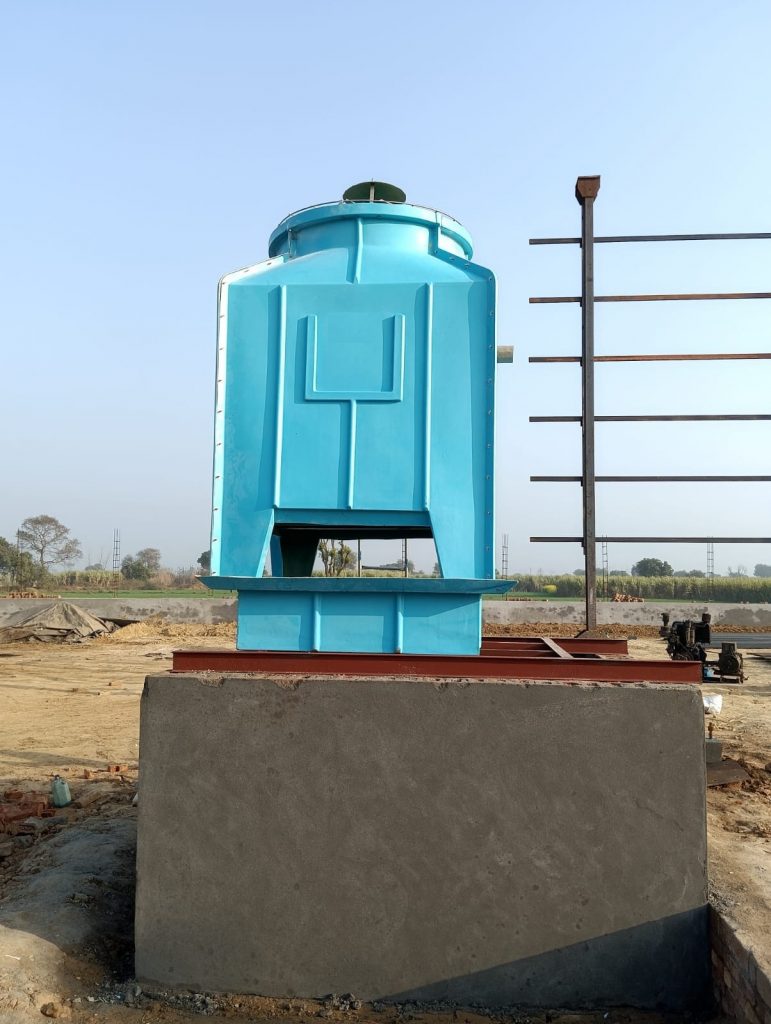Evaporative Cooling Towers
Evaporative cooling towers are heat rejection systems that use water evaporation to remove process heat efficiently. They are widely used in industries, HVAC systems, and power plants where large-scale cooling is required.
How Evaporative Cooling Towers Work
- Hot Water Inlet – Warm water from the process enters the tower.
- Distribution System – Water is sprayed or evenly distributed over fill media (to maximize surface area).
- Airflow – Fans (forced or induced draft) pull/push air through the fill.
- Evaporation – A small portion of water evaporates, absorbing heat and cooling the remaining water.
- Cooled Water Collection – The chilled water returns to the process.
Key Principle:
- Latent heat of vaporization (~1,000 BTU/lb of evaporated water) provides efficient cooling.
- Approach temperature (how close the water gets to wet-bulb temp) determines efficiency.
Types of Evaporative Cooling Towers
1. Open (Wet) Cooling Towers
- Process water is directly exposed to air.
- Highest efficiency but requires water treatment.
- Common in: Power plants, refineries, large HVAC.
2. Closed-Circuit (Hybrid) Cooling Towers
- Process fluid stays in a sealed coil.
- Evaporative cooling happens on the external surface.
- Best for: clean systems (data centres, medical facilities).
3. Hybrid (Wet/Dry) Cooling Towers
- Combines dry & evaporative cooling.
- Saves water by switching modes based on demand.
- Used in: Variable climates, water-scarce regions.
Advantages of Evaporative Cooling Towers
High Efficiency – Cools water close to wet-bulb temperature.
Energy Savings – Uses less power than air-cooled systems.
Cost-Effective – Lower operational costs than chillers.
Scalable – Suitable for small HVAC to industrial megaprojects.
Disadvantages & Challenges
Water Consumption – Evaporation, drift, and blowdown losses.
Maintenance Needs – Scaling, corrosion, and biofilm risks.
Legionella Risk – Requires strict water treatment.
Climate Sensitivity – Efficiency drops in high humidity.
Key Components
- Fill Media – Increases water-air contact (film or splash fill).
- Drift Eliminators – Reduce water loss from escaping droplets.
- Fans & Motors – Provide airflow (axial or centrifugal).
- Water Distribution System – Spray nozzles or gravity-fed basins.
- Basin – Collects cooled water for recirculation.
Applications
- Power Generation (condenser cooling in coal/nuclear plants).
- HVAC Systems (large buildings, data centres).
- Oil & Gas (refinery process cooling).
- Manufacturing (steel, chemical, food processing).
Maintenance Best Practices
- Water Treatment – Biocides, anti-scaling, and corrosion inhibitors.
- Fill Cleaning – Prevents clogging from deposits/biofilm.
- Fan & Belt Inspections – Ensures optimal airflow.
- Winterization – Freeze protection in cold climates.
Evaporative vs. Air-Cooled Systems
| Factor | Evaporative Cooling Tower | Air-Cooled Chiller |
| Efficiency | High (close to wet-bulb temp) | Lower (limited by dry-bulb temp) |
| Water Use | High (evaporation losses) | None |
| Energy Use | Lower (fans + pumps) | Higher (compressors + fans) |
| Footprint | Larger | Smaller |
| Maintenance | More intensive (water treatment) | Simpler |
Evaporative cooling towers are the most efficient way to reject large amounts of heat but require careful water management. They dominate industries where energy savings outweigh water costs.
Need help selecting the right type for your application? Ask about:
- Sizing calculations
- Water treatment solutions
Hybrid cooling options
